Cultural Diversity and Workplace Management: Amazon Research Project
VerifiedAdded on 2023/01/12
|33
|8579
|21
Report
AI Summary
This research project, titled "Managing cultural diversity in the workplace", examines the strategies and challenges of managing a diverse workforce, using Amazon as a case study. The project begins with an introduction outlining the research aim, objectives, and the rationale for selecting this topic, followed by a literature review that explores the importance of cultural diversity and equality in business management. The methodology chapter details the research approach and methods, including data collection and analysis. The data collection involved questionnaires. The findings chapter presents the results of the research, offering recommendations for effective cultural diversity management within Amazon. The report concludes with a personal reflective statement and areas for further research. The project aims to understand how to manage cultural diversity in the workplace by evaluating the importance of managing the cultural diversity in the workplace together with analysing the requirements and needs of effective management equality and diversity in order to have better business management.

Research Project
Paraphrase This Document
Need a fresh take? Get an instant paraphrase of this document with our AI Paraphraser
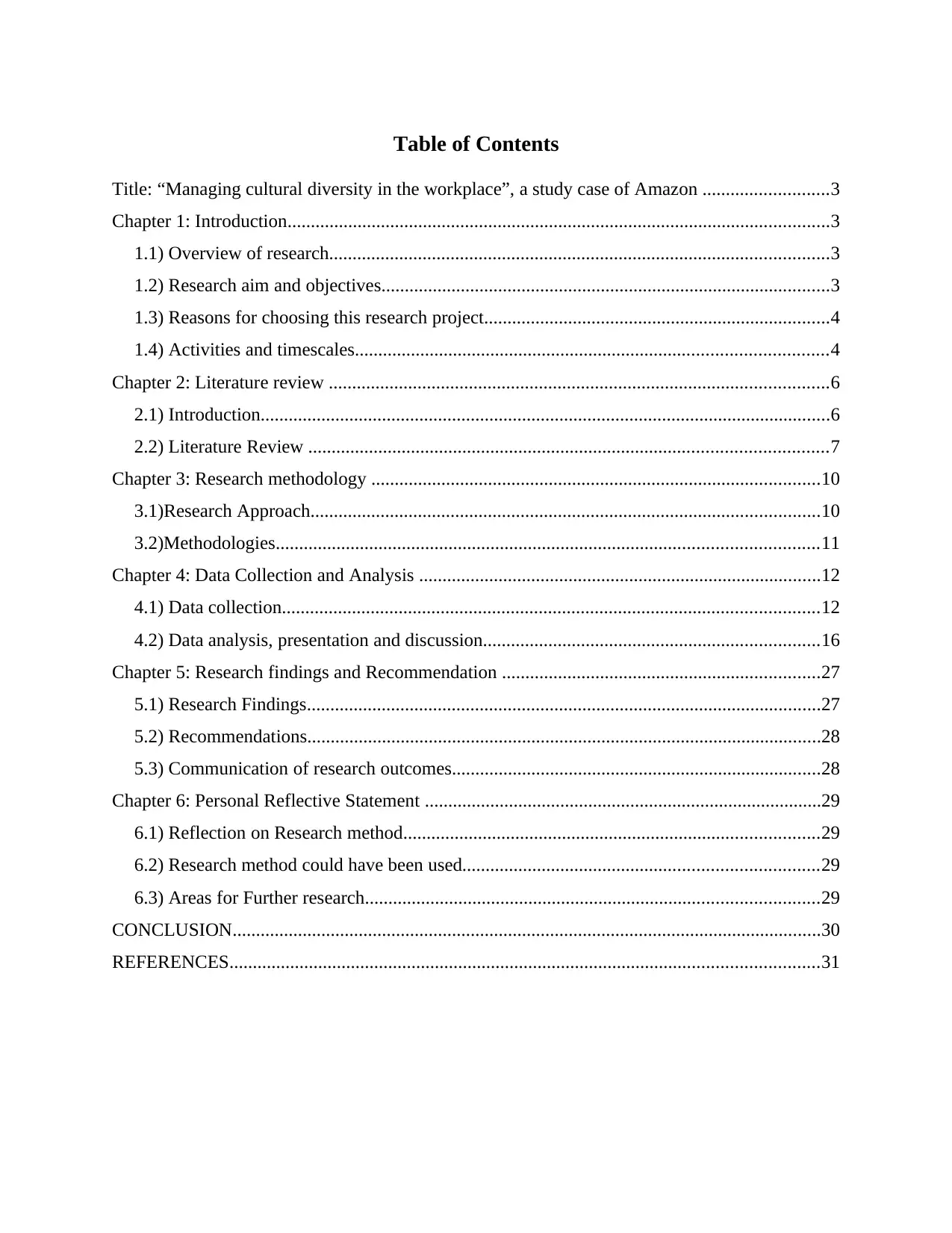
Table of Contents
Title: “Managing cultural diversity in the workplace”, a study case of Amazon ...........................3
Chapter 1: Introduction....................................................................................................................3
1.1) Overview of research...........................................................................................................3
1.2) Research aim and objectives................................................................................................3
1.3) Reasons for choosing this research project..........................................................................4
1.4) Activities and timescales.....................................................................................................4
Chapter 2: Literature review ...........................................................................................................6
2.1) Introduction..........................................................................................................................6
2.2) Literature Review ...............................................................................................................7
Chapter 3: Research methodology ................................................................................................10
3.1)Research Approach.............................................................................................................10
3.2)Methodologies....................................................................................................................11
Chapter 4: Data Collection and Analysis ......................................................................................12
4.1) Data collection...................................................................................................................12
4.2) Data analysis, presentation and discussion........................................................................16
Chapter 5: Research findings and Recommendation ....................................................................27
5.1) Research Findings..............................................................................................................27
5.2) Recommendations..............................................................................................................28
5.3) Communication of research outcomes...............................................................................28
Chapter 6: Personal Reflective Statement .....................................................................................29
6.1) Reflection on Research method.........................................................................................29
6.2) Research method could have been used............................................................................29
6.3) Areas for Further research.................................................................................................29
CONCLUSION..............................................................................................................................30
REFERENCES..............................................................................................................................31
Title: “Managing cultural diversity in the workplace”, a study case of Amazon ...........................3
Chapter 1: Introduction....................................................................................................................3
1.1) Overview of research...........................................................................................................3
1.2) Research aim and objectives................................................................................................3
1.3) Reasons for choosing this research project..........................................................................4
1.4) Activities and timescales.....................................................................................................4
Chapter 2: Literature review ...........................................................................................................6
2.1) Introduction..........................................................................................................................6
2.2) Literature Review ...............................................................................................................7
Chapter 3: Research methodology ................................................................................................10
3.1)Research Approach.............................................................................................................10
3.2)Methodologies....................................................................................................................11
Chapter 4: Data Collection and Analysis ......................................................................................12
4.1) Data collection...................................................................................................................12
4.2) Data analysis, presentation and discussion........................................................................16
Chapter 5: Research findings and Recommendation ....................................................................27
5.1) Research Findings..............................................................................................................27
5.2) Recommendations..............................................................................................................28
5.3) Communication of research outcomes...............................................................................28
Chapter 6: Personal Reflective Statement .....................................................................................29
6.1) Reflection on Research method.........................................................................................29
6.2) Research method could have been used............................................................................29
6.3) Areas for Further research.................................................................................................29
CONCLUSION..............................................................................................................................30
REFERENCES..............................................................................................................................31
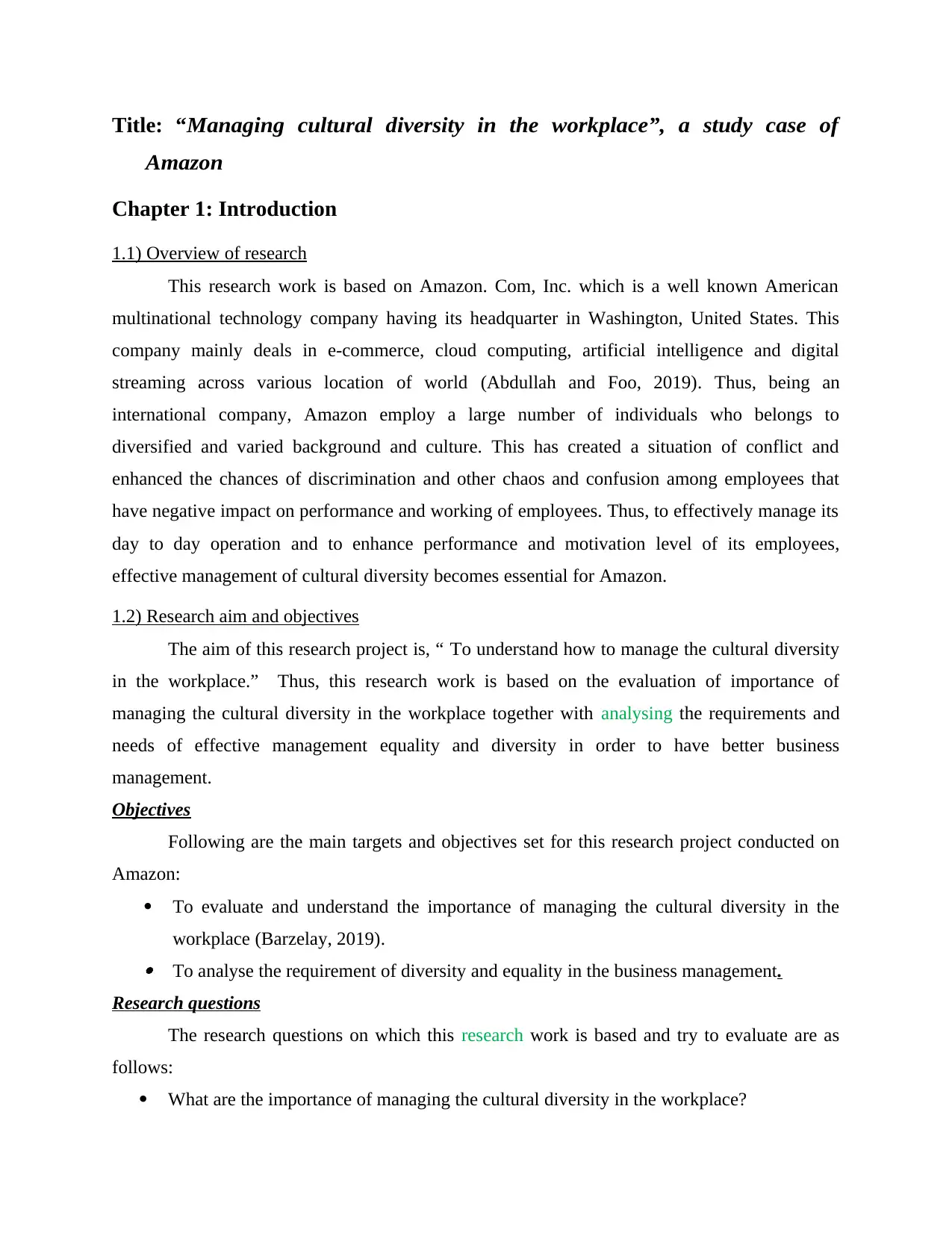
Title: “ Managing cultural diversity in the workplace”, a study case of
Amazon
Chapter 1: Introduction
1.1) Overview of research
This research work is based on Amazon. Com, Inc. which is a well known American
multinational technology company having its headquarter in Washington, United States. This
company mainly deals in e-commerce, cloud computing, artificial intelligence and digital
streaming across various location of world (Abdullah and Foo, 2019). Thus, being an
international company, Amazon employ a large number of individuals who belongs to
diversified and varied background and culture. This has created a situation of conflict and
enhanced the chances of discrimination and other chaos and confusion among employees that
have negative impact on performance and working of employees. Thus, to effectively manage its
day to day operation and to enhance performance and motivation level of its employees,
effective management of cultural diversity becomes essential for Amazon.
1.2) Research aim and objectives
The aim of this research project is, “ To understand how to manage the cultural diversity
in the workplace.” Thus, this research work is based on the evaluation of importance of
managing the cultural diversity in the workplace together with analysing the requirements and
needs of effective management equality and diversity in order to have better business
management.
Objectives
Following are the main targets and objectives set for this research project conducted on
Amazon:
To evaluate and understand the importance of managing the cultural diversity in the
workplace (Barzelay, 2019). To analyse the requirement of diversity and equality in the business management.
Research questions
The research questions on which this research work is based and try to evaluate are as
follows:
What are the importance of managing the cultural diversity in the workplace?
Amazon
Chapter 1: Introduction
1.1) Overview of research
This research work is based on Amazon. Com, Inc. which is a well known American
multinational technology company having its headquarter in Washington, United States. This
company mainly deals in e-commerce, cloud computing, artificial intelligence and digital
streaming across various location of world (Abdullah and Foo, 2019). Thus, being an
international company, Amazon employ a large number of individuals who belongs to
diversified and varied background and culture. This has created a situation of conflict and
enhanced the chances of discrimination and other chaos and confusion among employees that
have negative impact on performance and working of employees. Thus, to effectively manage its
day to day operation and to enhance performance and motivation level of its employees,
effective management of cultural diversity becomes essential for Amazon.
1.2) Research aim and objectives
The aim of this research project is, “ To understand how to manage the cultural diversity
in the workplace.” Thus, this research work is based on the evaluation of importance of
managing the cultural diversity in the workplace together with analysing the requirements and
needs of effective management equality and diversity in order to have better business
management.
Objectives
Following are the main targets and objectives set for this research project conducted on
Amazon:
To evaluate and understand the importance of managing the cultural diversity in the
workplace (Barzelay, 2019). To analyse the requirement of diversity and equality in the business management.
Research questions
The research questions on which this research work is based and try to evaluate are as
follows:
What are the importance of managing the cultural diversity in the workplace?
⊘ This is a preview!⊘
Do you want full access?
Subscribe today to unlock all pages.

Trusted by 1+ million students worldwide
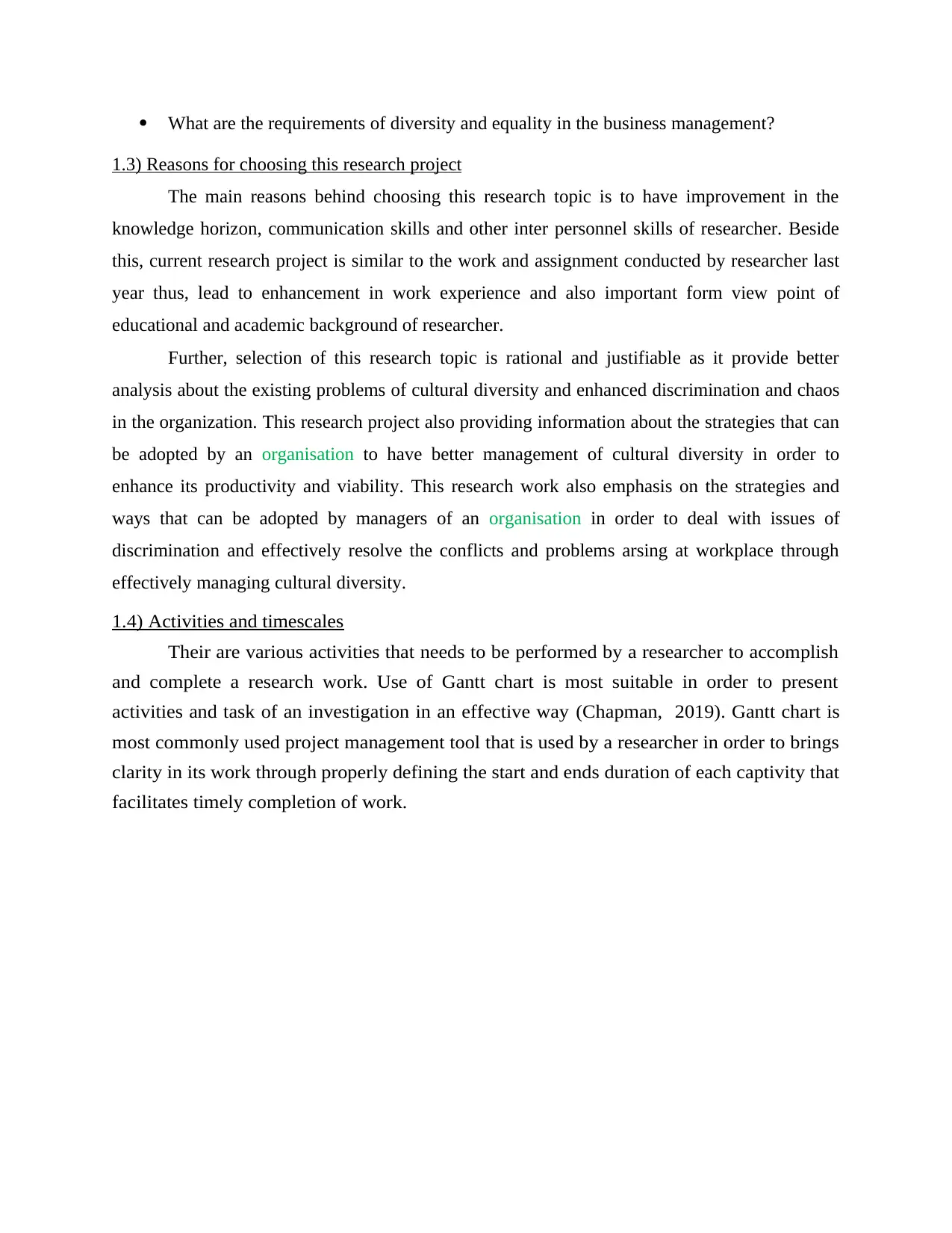
What are the requirements of diversity and equality in the business management?
1.3) Reasons for choosing this research project
The main reasons behind choosing this research topic is to have improvement in the
knowledge horizon, communication skills and other inter personnel skills of researcher. Beside
this, current research project is similar to the work and assignment conducted by researcher last
year thus, lead to enhancement in work experience and also important form view point of
educational and academic background of researcher.
Further, selection of this research topic is rational and justifiable as it provide better
analysis about the existing problems of cultural diversity and enhanced discrimination and chaos
in the organization. This research project also providing information about the strategies that can
be adopted by an organisation to have better management of cultural diversity in order to
enhance its productivity and viability. This research work also emphasis on the strategies and
ways that can be adopted by managers of an organisation in order to deal with issues of
discrimination and effectively resolve the conflicts and problems arsing at workplace through
effectively managing cultural diversity.
1.4) Activities and timescales
Their are various activities that needs to be performed by a researcher to accomplish
and complete a research work. Use of Gantt chart is most suitable in order to present
activities and task of an investigation in an effective way (Chapman, 2019). Gantt chart is
most commonly used project management tool that is used by a researcher in order to brings
clarity in its work through properly defining the start and ends duration of each captivity that
facilitates timely completion of work.
1.3) Reasons for choosing this research project
The main reasons behind choosing this research topic is to have improvement in the
knowledge horizon, communication skills and other inter personnel skills of researcher. Beside
this, current research project is similar to the work and assignment conducted by researcher last
year thus, lead to enhancement in work experience and also important form view point of
educational and academic background of researcher.
Further, selection of this research topic is rational and justifiable as it provide better
analysis about the existing problems of cultural diversity and enhanced discrimination and chaos
in the organization. This research project also providing information about the strategies that can
be adopted by an organisation to have better management of cultural diversity in order to
enhance its productivity and viability. This research work also emphasis on the strategies and
ways that can be adopted by managers of an organisation in order to deal with issues of
discrimination and effectively resolve the conflicts and problems arsing at workplace through
effectively managing cultural diversity.
1.4) Activities and timescales
Their are various activities that needs to be performed by a researcher to accomplish
and complete a research work. Use of Gantt chart is most suitable in order to present
activities and task of an investigation in an effective way (Chapman, 2019). Gantt chart is
most commonly used project management tool that is used by a researcher in order to brings
clarity in its work through properly defining the start and ends duration of each captivity that
facilitates timely completion of work.
Paraphrase This Document
Need a fresh take? Get an instant paraphrase of this document with our AI Paraphraser
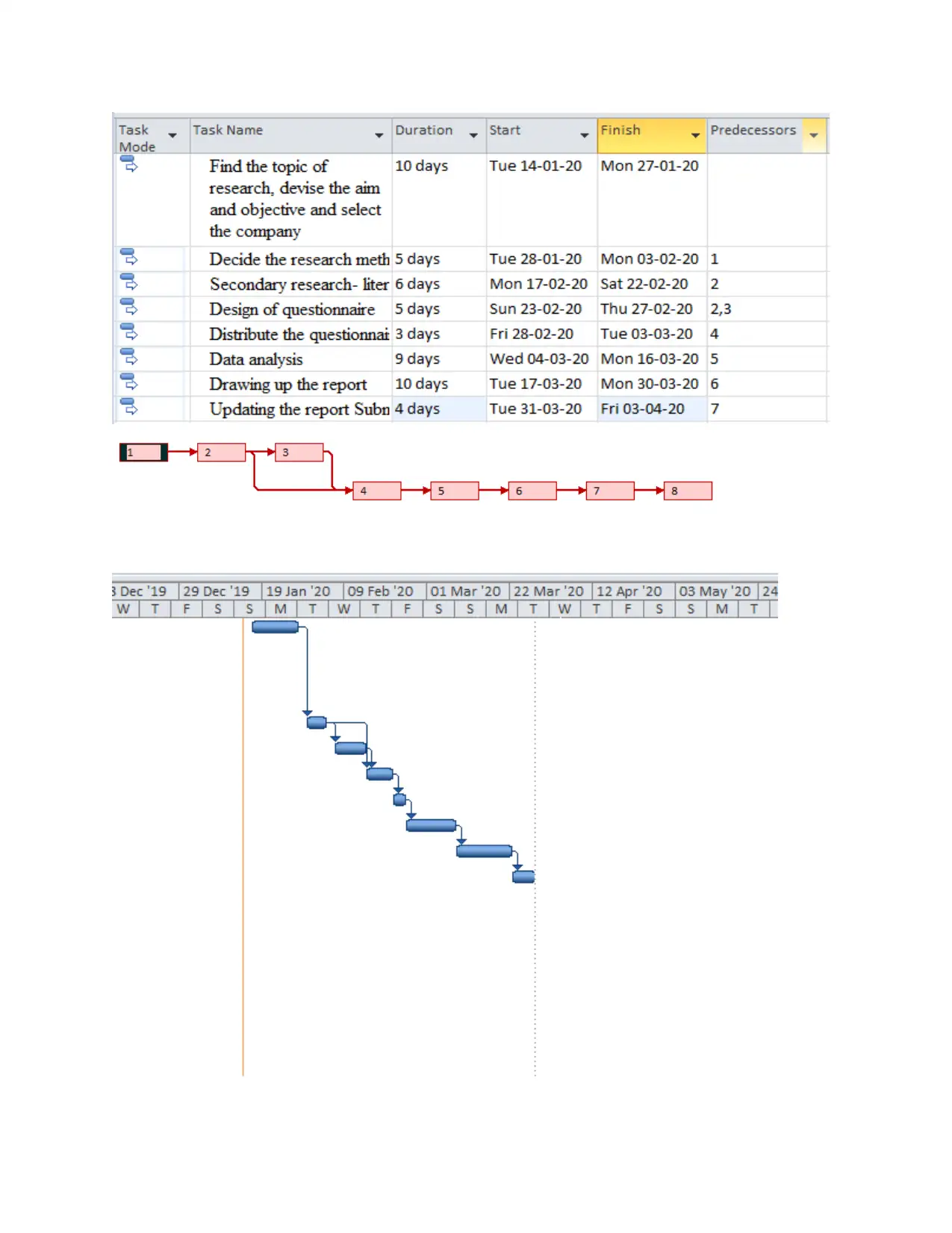
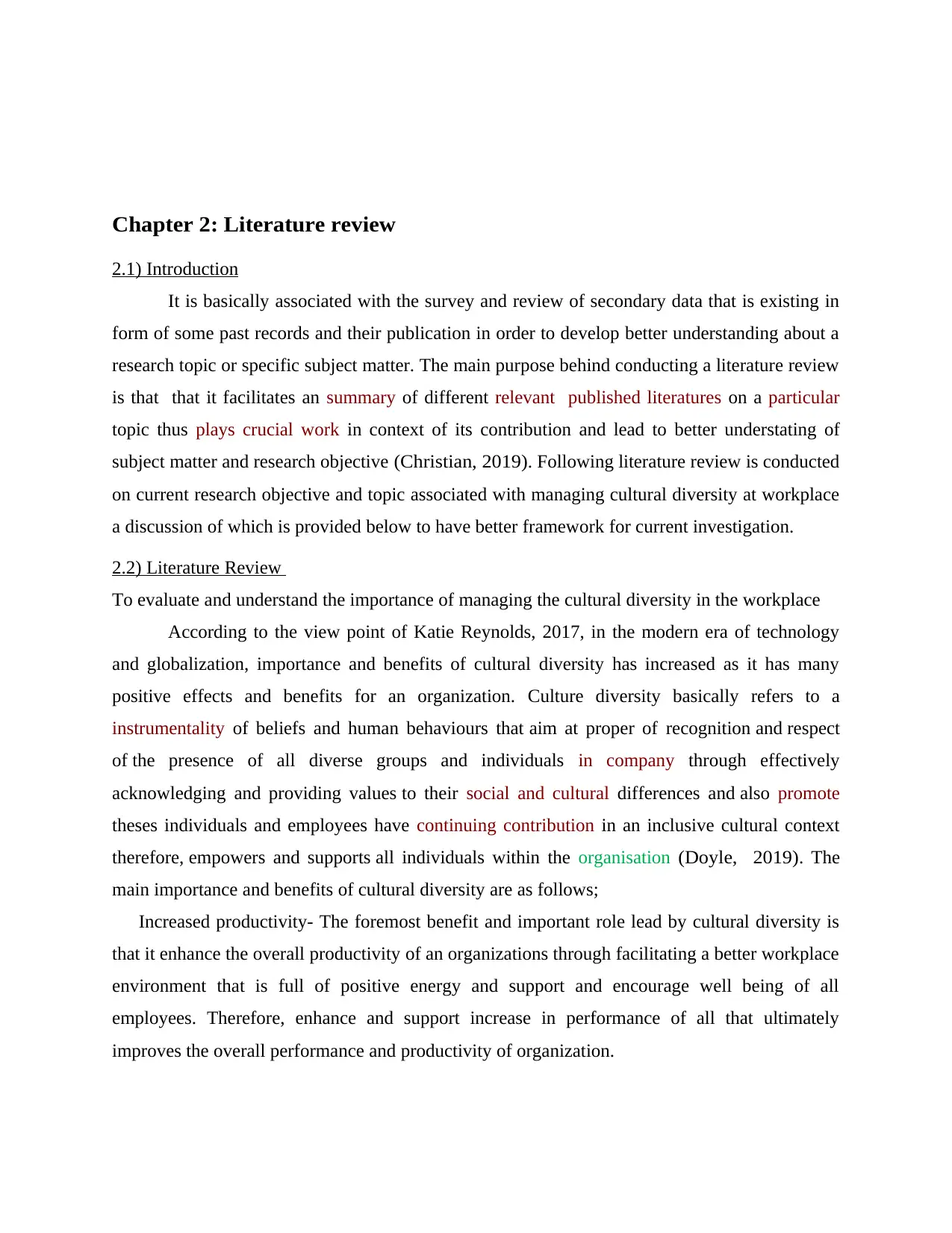
Chapter 2: Literature review
2.1) Introduction
It is basically associated with the survey and review of secondary data that is existing in
form of some past records and their publication in order to develop better understanding about a
research topic or specific subject matter. The main purpose behind conducting a literature review
is that that it facilitates an summary of different relevant published literatures on a particular
topic thus plays crucial work in context of its contribution and lead to better understating of
subject matter and research objective (Christian, 2019). Following literature review is conducted
on current research objective and topic associated with managing cultural diversity at workplace
a discussion of which is provided below to have better framework for current investigation.
2.2) Literature Review
To evaluate and understand the importance of managing the cultural diversity in the workplace
According to the view point of Katie Reynolds, 2017, in the modern era of technology
and globalization, importance and benefits of cultural diversity has increased as it has many
positive effects and benefits for an organization. Culture diversity basically refers to a
instrumentality of beliefs and human behaviours that aim at proper of recognition and respect
of the presence of all diverse groups and individuals in company through effectively
acknowledging and providing values to their social and cultural differences and also promote
theses individuals and employees have continuing contribution in an inclusive cultural context
therefore, empowers and supports all individuals within the organisation (Doyle, 2019). The
main importance and benefits of cultural diversity are as follows;
Increased productivity- The foremost benefit and important role lead by cultural diversity is
that it enhance the overall productivity of an organizations through facilitating a better workplace
environment that is full of positive energy and support and encourage well being of all
employees. Therefore, enhance and support increase in performance of all that ultimately
improves the overall performance and productivity of organization.
2.1) Introduction
It is basically associated with the survey and review of secondary data that is existing in
form of some past records and their publication in order to develop better understanding about a
research topic or specific subject matter. The main purpose behind conducting a literature review
is that that it facilitates an summary of different relevant published literatures on a particular
topic thus plays crucial work in context of its contribution and lead to better understating of
subject matter and research objective (Christian, 2019). Following literature review is conducted
on current research objective and topic associated with managing cultural diversity at workplace
a discussion of which is provided below to have better framework for current investigation.
2.2) Literature Review
To evaluate and understand the importance of managing the cultural diversity in the workplace
According to the view point of Katie Reynolds, 2017, in the modern era of technology
and globalization, importance and benefits of cultural diversity has increased as it has many
positive effects and benefits for an organization. Culture diversity basically refers to a
instrumentality of beliefs and human behaviours that aim at proper of recognition and respect
of the presence of all diverse groups and individuals in company through effectively
acknowledging and providing values to their social and cultural differences and also promote
theses individuals and employees have continuing contribution in an inclusive cultural context
therefore, empowers and supports all individuals within the organisation (Doyle, 2019). The
main importance and benefits of cultural diversity are as follows;
Increased productivity- The foremost benefit and important role lead by cultural diversity is
that it enhance the overall productivity of an organizations through facilitating a better workplace
environment that is full of positive energy and support and encourage well being of all
employees. Therefore, enhance and support increase in performance of all that ultimately
improves the overall performance and productivity of organization.
⊘ This is a preview!⊘
Do you want full access?
Subscribe today to unlock all pages.

Trusted by 1+ million students worldwide
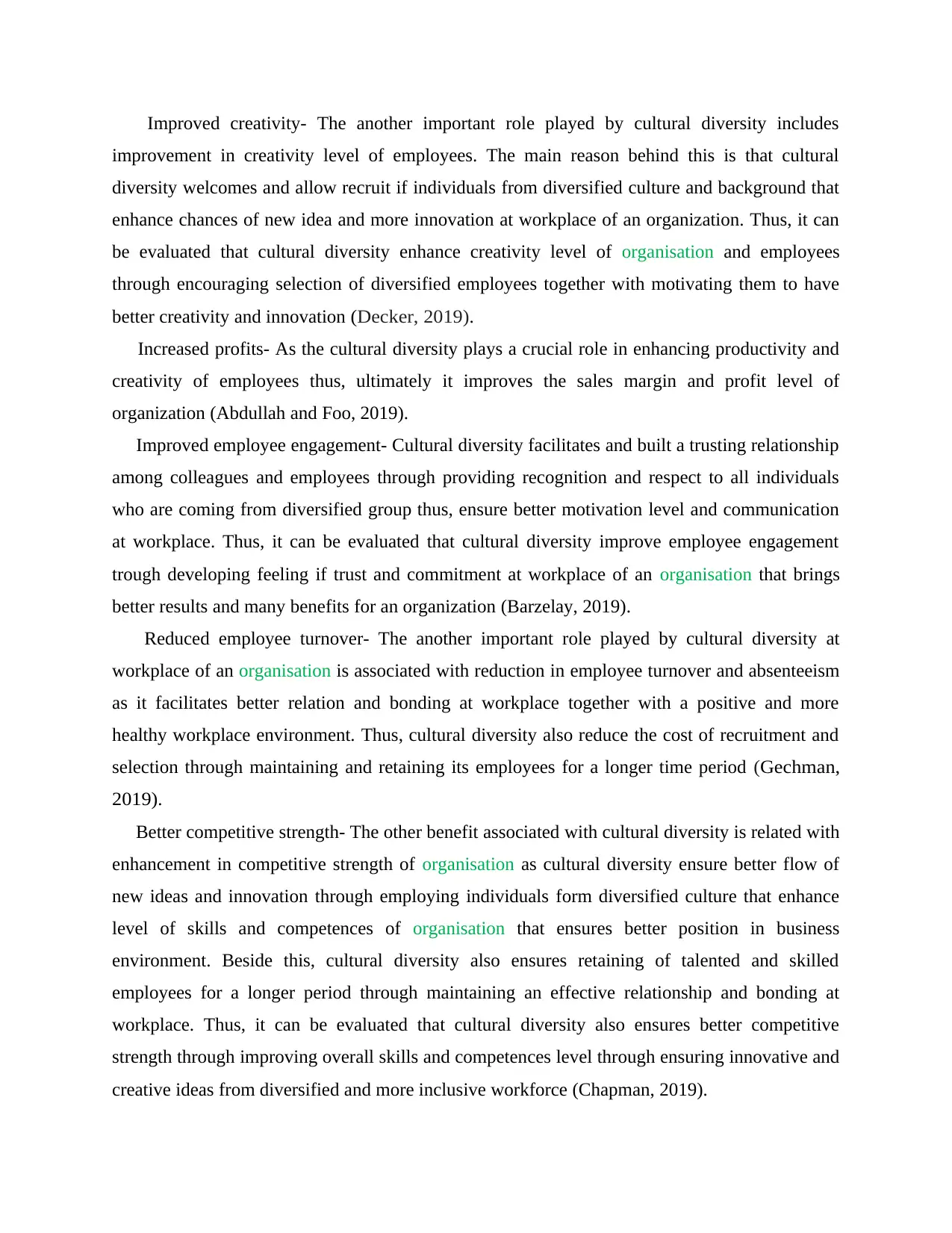
Improved creativity- The another important role played by cultural diversity includes
improvement in creativity level of employees. The main reason behind this is that cultural
diversity welcomes and allow recruit if individuals from diversified culture and background that
enhance chances of new idea and more innovation at workplace of an organization. Thus, it can
be evaluated that cultural diversity enhance creativity level of organisation and employees
through encouraging selection of diversified employees together with motivating them to have
better creativity and innovation (Decker, 2019).
Increased profits- As the cultural diversity plays a crucial role in enhancing productivity and
creativity of employees thus, ultimately it improves the sales margin and profit level of
organization (Abdullah and Foo, 2019).
Improved employee engagement- Cultural diversity facilitates and built a trusting relationship
among colleagues and employees through providing recognition and respect to all individuals
who are coming from diversified group thus, ensure better motivation level and communication
at workplace. Thus, it can be evaluated that cultural diversity improve employee engagement
trough developing feeling if trust and commitment at workplace of an organisation that brings
better results and many benefits for an organization (Barzelay, 2019).
Reduced employee turnover- The another important role played by cultural diversity at
workplace of an organisation is associated with reduction in employee turnover and absenteeism
as it facilitates better relation and bonding at workplace together with a positive and more
healthy workplace environment. Thus, cultural diversity also reduce the cost of recruitment and
selection through maintaining and retaining its employees for a longer time period (Gechman,
2019).
Better competitive strength- The other benefit associated with cultural diversity is related with
enhancement in competitive strength of organisation as cultural diversity ensure better flow of
new ideas and innovation through employing individuals form diversified culture that enhance
level of skills and competences of organisation that ensures better position in business
environment. Beside this, cultural diversity also ensures retaining of talented and skilled
employees for a longer period through maintaining an effective relationship and bonding at
workplace. Thus, it can be evaluated that cultural diversity also ensures better competitive
strength through improving overall skills and competences level through ensuring innovative and
creative ideas from diversified and more inclusive workforce (Chapman, 2019).
improvement in creativity level of employees. The main reason behind this is that cultural
diversity welcomes and allow recruit if individuals from diversified culture and background that
enhance chances of new idea and more innovation at workplace of an organization. Thus, it can
be evaluated that cultural diversity enhance creativity level of organisation and employees
through encouraging selection of diversified employees together with motivating them to have
better creativity and innovation (Decker, 2019).
Increased profits- As the cultural diversity plays a crucial role in enhancing productivity and
creativity of employees thus, ultimately it improves the sales margin and profit level of
organization (Abdullah and Foo, 2019).
Improved employee engagement- Cultural diversity facilitates and built a trusting relationship
among colleagues and employees through providing recognition and respect to all individuals
who are coming from diversified group thus, ensure better motivation level and communication
at workplace. Thus, it can be evaluated that cultural diversity improve employee engagement
trough developing feeling if trust and commitment at workplace of an organisation that brings
better results and many benefits for an organization (Barzelay, 2019).
Reduced employee turnover- The another important role played by cultural diversity at
workplace of an organisation is associated with reduction in employee turnover and absenteeism
as it facilitates better relation and bonding at workplace together with a positive and more
healthy workplace environment. Thus, cultural diversity also reduce the cost of recruitment and
selection through maintaining and retaining its employees for a longer time period (Gechman,
2019).
Better competitive strength- The other benefit associated with cultural diversity is related with
enhancement in competitive strength of organisation as cultural diversity ensure better flow of
new ideas and innovation through employing individuals form diversified culture that enhance
level of skills and competences of organisation that ensures better position in business
environment. Beside this, cultural diversity also ensures retaining of talented and skilled
employees for a longer period through maintaining an effective relationship and bonding at
workplace. Thus, it can be evaluated that cultural diversity also ensures better competitive
strength through improving overall skills and competences level through ensuring innovative and
creative ideas from diversified and more inclusive workforce (Chapman, 2019).
Paraphrase This Document
Need a fresh take? Get an instant paraphrase of this document with our AI Paraphraser
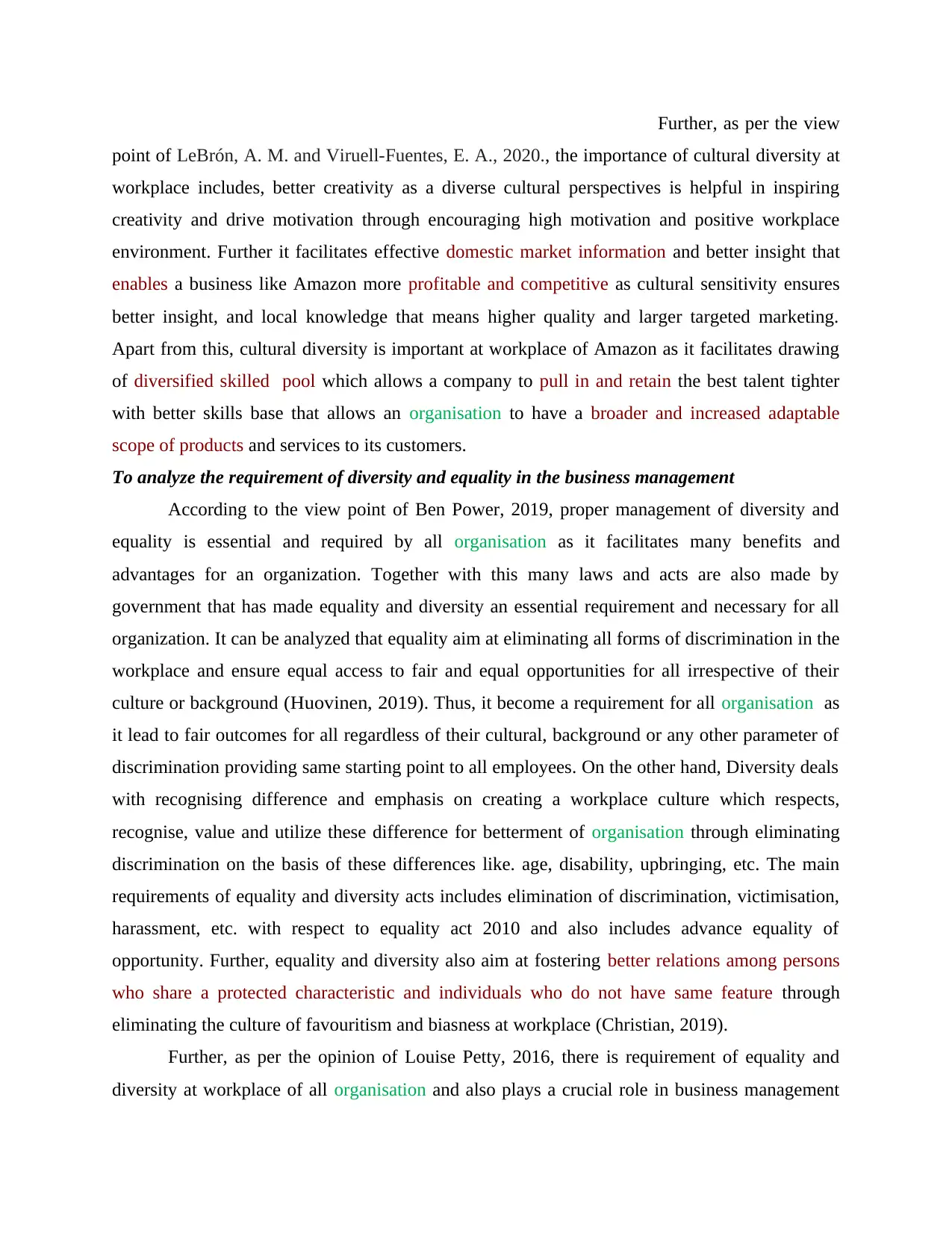
Further, as per the view
point of LeBrón, A. M. and Viruell-Fuentes, E. A., 2020., the importance of cultural diversity at
workplace includes, better creativity as a diverse cultural perspectives is helpful in inspiring
creativity and drive motivation through encouraging high motivation and positive workplace
environment. Further it facilitates effective domestic market information and better insight that
enables a business like Amazon more profitable and competitive as cultural sensitivity ensures
better insight, and local knowledge that means higher quality and larger targeted marketing.
Apart from this, cultural diversity is important at workplace of Amazon as it facilitates drawing
of diversified skilled pool which allows a company to pull in and retain the best talent tighter
with better skills base that allows an organisation to have a broader and increased adaptable
scope of products and services to its customers.
To analyze the requirement of diversity and equality in the business management
According to the view point of Ben Power, 2019, proper management of diversity and
equality is essential and required by all organisation as it facilitates many benefits and
advantages for an organization. Together with this many laws and acts are also made by
government that has made equality and diversity an essential requirement and necessary for all
organization. It can be analyzed that equality aim at eliminating all forms of discrimination in the
workplace and ensure equal access to fair and equal opportunities for all irrespective of their
culture or background (Huovinen, 2019). Thus, it become a requirement for all organisation as
it lead to fair outcomes for all regardless of their cultural, background or any other parameter of
discrimination providing same starting point to all employees. On the other hand, Diversity deals
with recognising difference and emphasis on creating a workplace culture which respects,
recognise, value and utilize these difference for betterment of organisation through eliminating
discrimination on the basis of these differences like. age, disability, upbringing, etc. The main
requirements of equality and diversity acts includes elimination of discrimination, victimisation,
harassment, etc. with respect to equality act 2010 and also includes advance equality of
opportunity. Further, equality and diversity also aim at fostering better relations among persons
who share a protected characteristic and individuals who do not have same feature through
eliminating the culture of favouritism and biasness at workplace (Christian, 2019).
Further, as per the opinion of Louise Petty, 2016, there is requirement of equality and
diversity at workplace of all organisation and also plays a crucial role in business management
point of LeBrón, A. M. and Viruell-Fuentes, E. A., 2020., the importance of cultural diversity at
workplace includes, better creativity as a diverse cultural perspectives is helpful in inspiring
creativity and drive motivation through encouraging high motivation and positive workplace
environment. Further it facilitates effective domestic market information and better insight that
enables a business like Amazon more profitable and competitive as cultural sensitivity ensures
better insight, and local knowledge that means higher quality and larger targeted marketing.
Apart from this, cultural diversity is important at workplace of Amazon as it facilitates drawing
of diversified skilled pool which allows a company to pull in and retain the best talent tighter
with better skills base that allows an organisation to have a broader and increased adaptable
scope of products and services to its customers.
To analyze the requirement of diversity and equality in the business management
According to the view point of Ben Power, 2019, proper management of diversity and
equality is essential and required by all organisation as it facilitates many benefits and
advantages for an organization. Together with this many laws and acts are also made by
government that has made equality and diversity an essential requirement and necessary for all
organization. It can be analyzed that equality aim at eliminating all forms of discrimination in the
workplace and ensure equal access to fair and equal opportunities for all irrespective of their
culture or background (Huovinen, 2019). Thus, it become a requirement for all organisation as
it lead to fair outcomes for all regardless of their cultural, background or any other parameter of
discrimination providing same starting point to all employees. On the other hand, Diversity deals
with recognising difference and emphasis on creating a workplace culture which respects,
recognise, value and utilize these difference for betterment of organisation through eliminating
discrimination on the basis of these differences like. age, disability, upbringing, etc. The main
requirements of equality and diversity acts includes elimination of discrimination, victimisation,
harassment, etc. with respect to equality act 2010 and also includes advance equality of
opportunity. Further, equality and diversity also aim at fostering better relations among persons
who share a protected characteristic and individuals who do not have same feature through
eliminating the culture of favouritism and biasness at workplace (Christian, 2019).
Further, as per the opinion of Louise Petty, 2016, there is requirement of equality and
diversity at workplace of all organisation and also plays a crucial role in business management
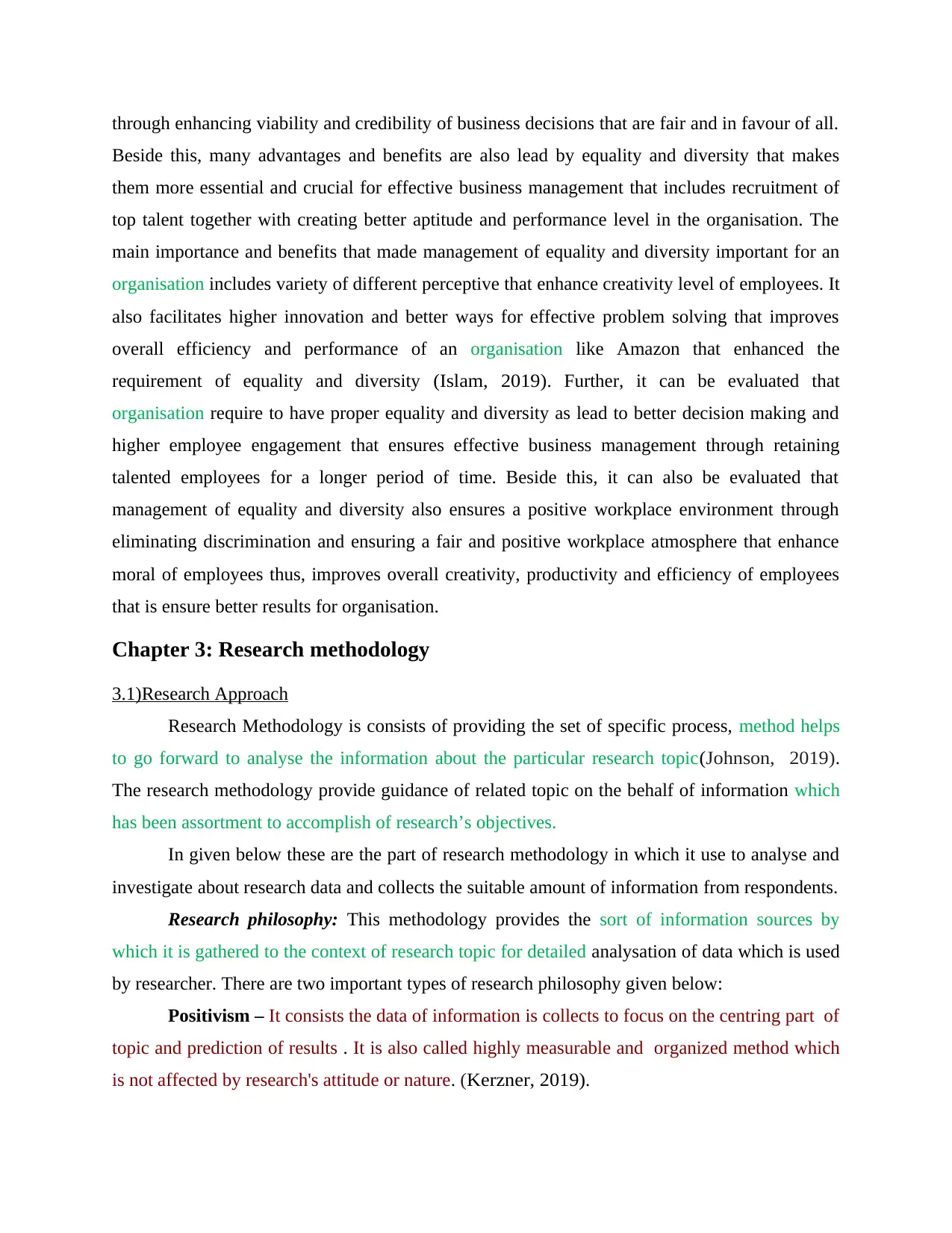
through enhancing viability and credibility of business decisions that are fair and in favour of all.
Beside this, many advantages and benefits are also lead by equality and diversity that makes
them more essential and crucial for effective business management that includes recruitment of
top talent together with creating better aptitude and performance level in the organisation. The
main importance and benefits that made management of equality and diversity important for an
organisation includes variety of different perceptive that enhance creativity level of employees. It
also facilitates higher innovation and better ways for effective problem solving that improves
overall efficiency and performance of an organisation like Amazon that enhanced the
requirement of equality and diversity (Islam, 2019). Further, it can be evaluated that
organisation require to have proper equality and diversity as lead to better decision making and
higher employee engagement that ensures effective business management through retaining
talented employees for a longer period of time. Beside this, it can also be evaluated that
management of equality and diversity also ensures a positive workplace environment through
eliminating discrimination and ensuring a fair and positive workplace atmosphere that enhance
moral of employees thus, improves overall creativity, productivity and efficiency of employees
that is ensure better results for organisation.
Chapter 3: Research methodology
3.1)Research Approach
Research Methodology is consists of providing the set of specific process, method helps
to go forward to analyse the information about the particular research topic (Johnson, 2019).
The research methodology provide guidance of related topic on the behalf of information which
has been assortment to accomplish of research’s objectives.
In given below these are the part of research methodology in which it use to analyse and
investigate about research data and collects the suitable amount of information from respondents.
Research philosophy: This methodology provides the sort of information sources by
which it is gathered to the context of research topic for detailed analysation of data which is used
by researcher. There are two important types of research philosophy given below:
Positivism – It consists the data of information is collects to focus on the centring part of
topic and prediction of results . It is also called highly measurable and organized method which
is not affected by research's attitude or nature. (Kerzner, 2019).
Beside this, many advantages and benefits are also lead by equality and diversity that makes
them more essential and crucial for effective business management that includes recruitment of
top talent together with creating better aptitude and performance level in the organisation. The
main importance and benefits that made management of equality and diversity important for an
organisation includes variety of different perceptive that enhance creativity level of employees. It
also facilitates higher innovation and better ways for effective problem solving that improves
overall efficiency and performance of an organisation like Amazon that enhanced the
requirement of equality and diversity (Islam, 2019). Further, it can be evaluated that
organisation require to have proper equality and diversity as lead to better decision making and
higher employee engagement that ensures effective business management through retaining
talented employees for a longer period of time. Beside this, it can also be evaluated that
management of equality and diversity also ensures a positive workplace environment through
eliminating discrimination and ensuring a fair and positive workplace atmosphere that enhance
moral of employees thus, improves overall creativity, productivity and efficiency of employees
that is ensure better results for organisation.
Chapter 3: Research methodology
3.1)Research Approach
Research Methodology is consists of providing the set of specific process, method helps
to go forward to analyse the information about the particular research topic (Johnson, 2019).
The research methodology provide guidance of related topic on the behalf of information which
has been assortment to accomplish of research’s objectives.
In given below these are the part of research methodology in which it use to analyse and
investigate about research data and collects the suitable amount of information from respondents.
Research philosophy: This methodology provides the sort of information sources by
which it is gathered to the context of research topic for detailed analysation of data which is used
by researcher. There are two important types of research philosophy given below:
Positivism – It consists the data of information is collects to focus on the centring part of
topic and prediction of results . It is also called highly measurable and organized method which
is not affected by research's attitude or nature. (Kerzner, 2019).
⊘ This is a preview!⊘
Do you want full access?
Subscribe today to unlock all pages.

Trusted by 1+ million students worldwide
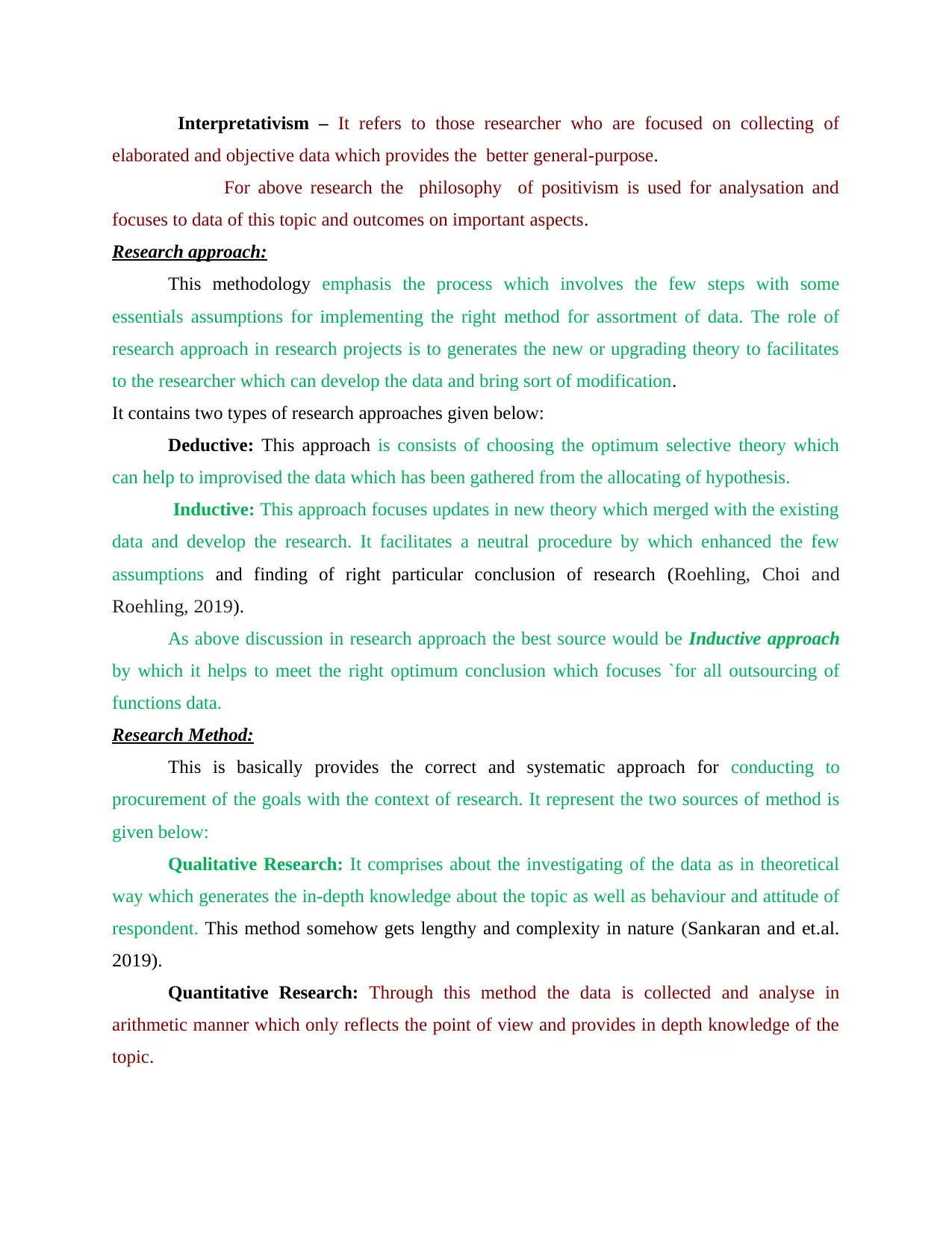
Interpretativism – It refers to those researcher who are focused on collecting of
elaborated and objective data which provides the better general-purpose.
For above research the philosophy of positivism is used for analysation and
focuses to data of this topic and outcomes on important aspects.
Research approach:
This methodology emphasis the process which involves the few steps with some
essentials assumptions for implementing the right method for assortment of data. The role of
research approach in research projects is to generates the new or upgrading theory to facilitates
to the researcher which can develop the data and bring sort of modification.
It contains two types of research approaches given below:
Deductive: This approach is consists of choosing the optimum selective theory which
can help to improvised the data which has been gathered from the allocating of hypothesis.
Inductive: This approach focuses updates in new theory which merged with the existing
data and develop the research. It facilitates a neutral procedure by which enhanced the few
assumptions and finding of right particular conclusion of research (Roehling, Choi and
Roehling, 2019).
As above discussion in research approach the best source would be Inductive approach
by which it helps to meet the right optimum conclusion which focuses `for all outsourcing of
functions data.
Research Method:
This is basically provides the correct and systematic approach for conducting to
procurement of the goals with the context of research. It represent the two sources of method is
given below:
Qualitative Research: It comprises about the investigating of the data as in theoretical
way which generates the in-depth knowledge about the topic as well as behaviour and attitude of
respondent. This method somehow gets lengthy and complexity in nature (Sankaran and et.al.
2019).
Quantitative Research: Through this method the data is collected and analyse in
arithmetic manner which only reflects the point of view and provides in depth knowledge of the
topic.
elaborated and objective data which provides the better general-purpose.
For above research the philosophy of positivism is used for analysation and
focuses to data of this topic and outcomes on important aspects.
Research approach:
This methodology emphasis the process which involves the few steps with some
essentials assumptions for implementing the right method for assortment of data. The role of
research approach in research projects is to generates the new or upgrading theory to facilitates
to the researcher which can develop the data and bring sort of modification.
It contains two types of research approaches given below:
Deductive: This approach is consists of choosing the optimum selective theory which
can help to improvised the data which has been gathered from the allocating of hypothesis.
Inductive: This approach focuses updates in new theory which merged with the existing
data and develop the research. It facilitates a neutral procedure by which enhanced the few
assumptions and finding of right particular conclusion of research (Roehling, Choi and
Roehling, 2019).
As above discussion in research approach the best source would be Inductive approach
by which it helps to meet the right optimum conclusion which focuses `for all outsourcing of
functions data.
Research Method:
This is basically provides the correct and systematic approach for conducting to
procurement of the goals with the context of research. It represent the two sources of method is
given below:
Qualitative Research: It comprises about the investigating of the data as in theoretical
way which generates the in-depth knowledge about the topic as well as behaviour and attitude of
respondent. This method somehow gets lengthy and complexity in nature (Sankaran and et.al.
2019).
Quantitative Research: Through this method the data is collected and analyse in
arithmetic manner which only reflects the point of view and provides in depth knowledge of the
topic.
Paraphrase This Document
Need a fresh take? Get an instant paraphrase of this document with our AI Paraphraser
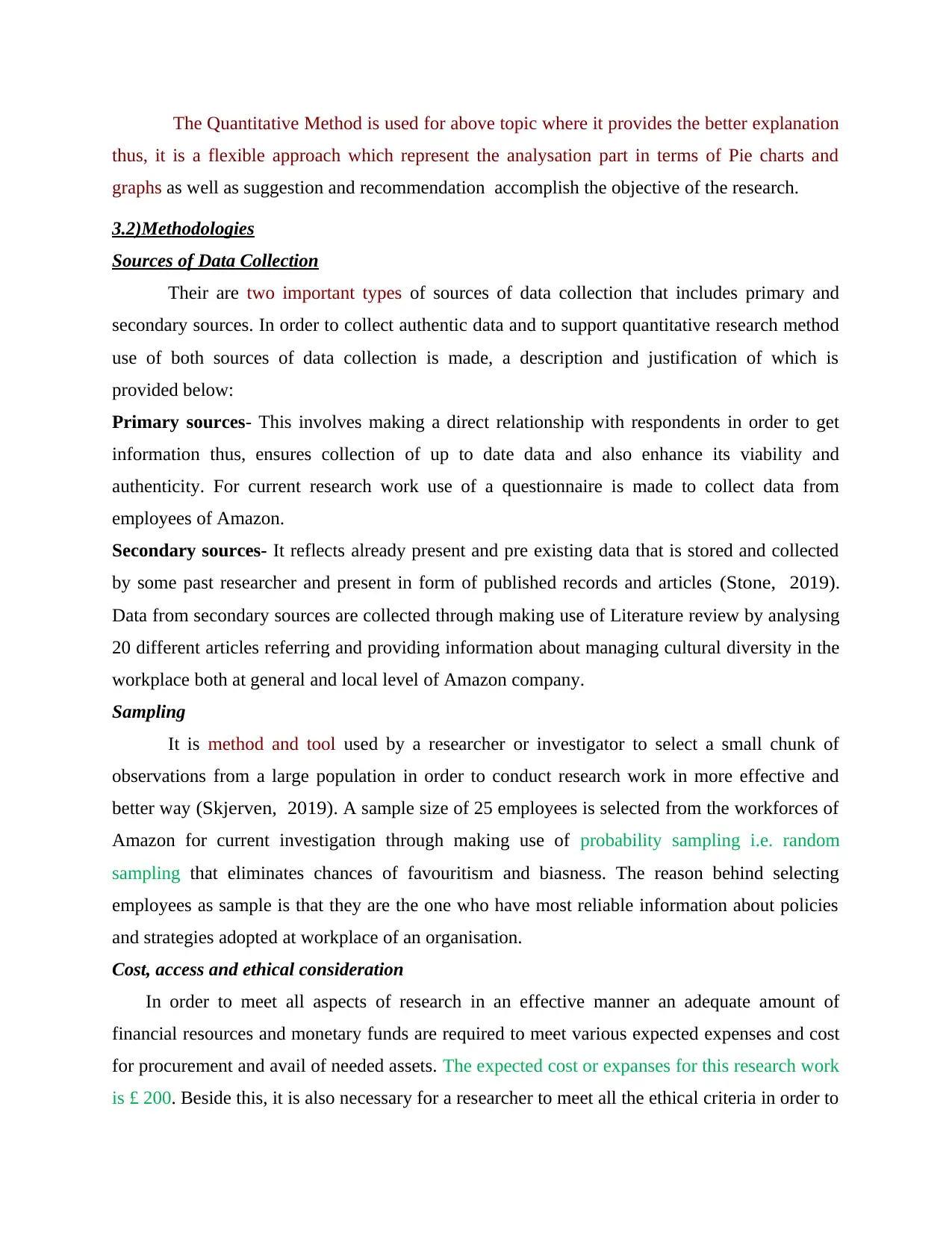
The Quantitative Method is used for above topic where it provides the better explanation
thus, it is a flexible approach which represent the analysation part in terms of Pie charts and
graphs as well as suggestion and recommendation accomplish the objective of the research.
3.2)Methodologies
Sources of Data Collection
Their are two important types of sources of data collection that includes primary and
secondary sources. In order to collect authentic data and to support quantitative research method
use of both sources of data collection is made, a description and justification of which is
provided below:
Primary sources- This involves making a direct relationship with respondents in order to get
information thus, ensures collection of up to date data and also enhance its viability and
authenticity. For current research work use of a questionnaire is made to collect data from
employees of Amazon.
Secondary sources- It reflects already present and pre existing data that is stored and collected
by some past researcher and present in form of published records and articles (Stone, 2019).
Data from secondary sources are collected through making use of Literature review by analysing
20 different articles referring and providing information about managing cultural diversity in the
workplace both at general and local level of Amazon company.
Sampling
It is method and tool used by a researcher or investigator to select a small chunk of
observations from a large population in order to conduct research work in more effective and
better way (Skjerven, 2019). A sample size of 25 employees is selected from the workforces of
Amazon for current investigation through making use of probability sampling i.e. random
sampling that eliminates chances of favouritism and biasness. The reason behind selecting
employees as sample is that they are the one who have most reliable information about policies
and strategies adopted at workplace of an organisation.
Cost, access and ethical consideration
In order to meet all aspects of research in an effective manner an adequate amount of
financial resources and monetary funds are required to meet various expected expenses and cost
for procurement and avail of needed assets. The expected cost or expanses for this research work
is £ 200. Beside this, it is also necessary for a researcher to meet all the ethical criteria in order to
thus, it is a flexible approach which represent the analysation part in terms of Pie charts and
graphs as well as suggestion and recommendation accomplish the objective of the research.
3.2)Methodologies
Sources of Data Collection
Their are two important types of sources of data collection that includes primary and
secondary sources. In order to collect authentic data and to support quantitative research method
use of both sources of data collection is made, a description and justification of which is
provided below:
Primary sources- This involves making a direct relationship with respondents in order to get
information thus, ensures collection of up to date data and also enhance its viability and
authenticity. For current research work use of a questionnaire is made to collect data from
employees of Amazon.
Secondary sources- It reflects already present and pre existing data that is stored and collected
by some past researcher and present in form of published records and articles (Stone, 2019).
Data from secondary sources are collected through making use of Literature review by analysing
20 different articles referring and providing information about managing cultural diversity in the
workplace both at general and local level of Amazon company.
Sampling
It is method and tool used by a researcher or investigator to select a small chunk of
observations from a large population in order to conduct research work in more effective and
better way (Skjerven, 2019). A sample size of 25 employees is selected from the workforces of
Amazon for current investigation through making use of probability sampling i.e. random
sampling that eliminates chances of favouritism and biasness. The reason behind selecting
employees as sample is that they are the one who have most reliable information about policies
and strategies adopted at workplace of an organisation.
Cost, access and ethical consideration
In order to meet all aspects of research in an effective manner an adequate amount of
financial resources and monetary funds are required to meet various expected expenses and cost
for procurement and avail of needed assets. The expected cost or expanses for this research work
is £ 200. Beside this, it is also necessary for a researcher to meet all the ethical criteria in order to
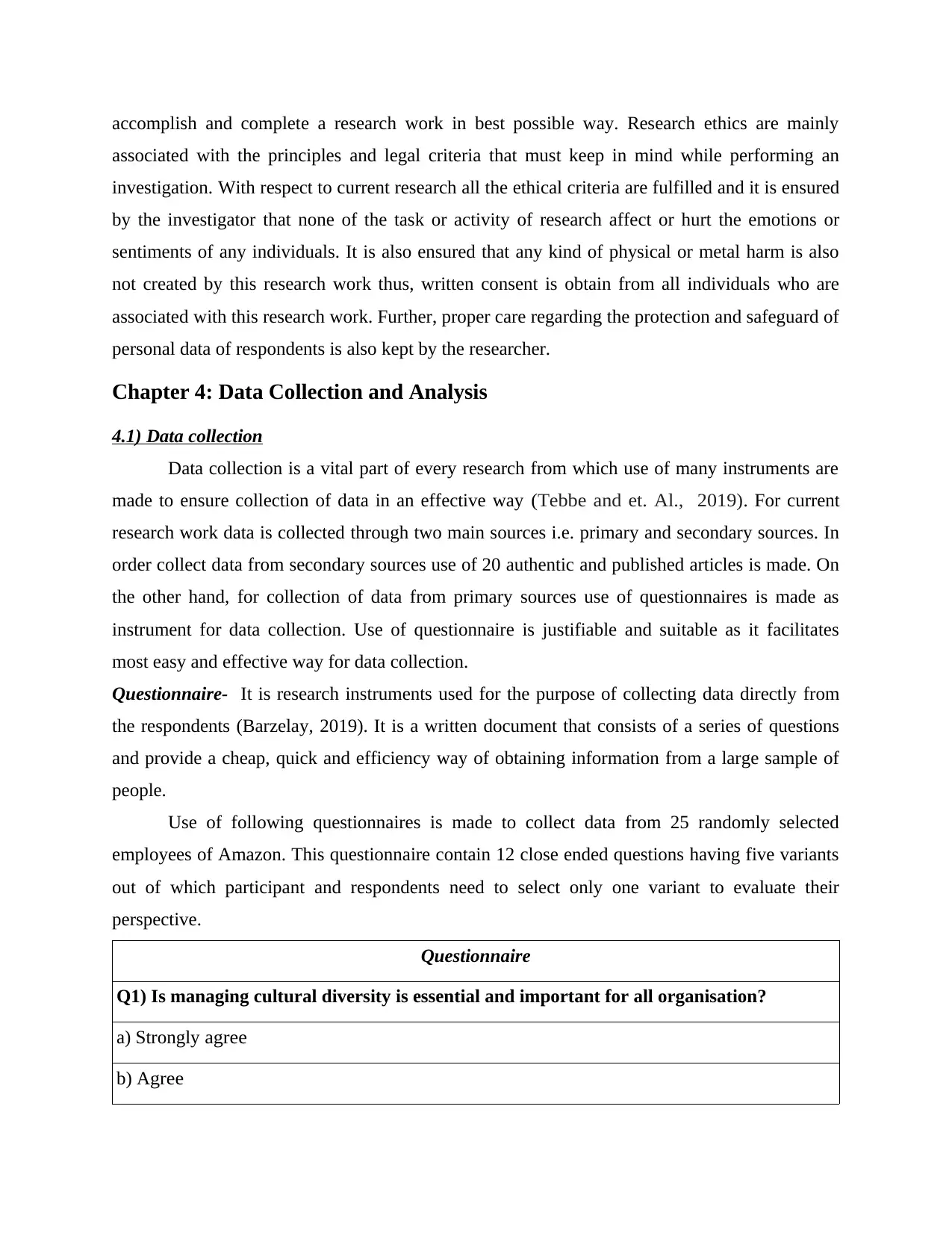
accomplish and complete a research work in best possible way. Research ethics are mainly
associated with the principles and legal criteria that must keep in mind while performing an
investigation. With respect to current research all the ethical criteria are fulfilled and it is ensured
by the investigator that none of the task or activity of research affect or hurt the emotions or
sentiments of any individuals. It is also ensured that any kind of physical or metal harm is also
not created by this research work thus, written consent is obtain from all individuals who are
associated with this research work. Further, proper care regarding the protection and safeguard of
personal data of respondents is also kept by the researcher.
Chapter 4: Data Collection and Analysis
4.1) Data collection
Data collection is a vital part of every research from which use of many instruments are
made to ensure collection of data in an effective way (Tebbe and et. Al., 2019). For current
research work data is collected through two main sources i.e. primary and secondary sources. In
order collect data from secondary sources use of 20 authentic and published articles is made. On
the other hand, for collection of data from primary sources use of questionnaires is made as
instrument for data collection. Use of questionnaire is justifiable and suitable as it facilitates
most easy and effective way for data collection.
Questionnaire- It is research instruments used for the purpose of collecting data directly from
the respondents (Barzelay, 2019). It is a written document that consists of a series of questions
and provide a cheap, quick and efficiency way of obtaining information from a large sample of
people.
Use of following questionnaires is made to collect data from 25 randomly selected
employees of Amazon. This questionnaire contain 12 close ended questions having five variants
out of which participant and respondents need to select only one variant to evaluate their
perspective.
Questionnaire
Q1) Is managing cultural diversity is essential and important for all organisation?
a) Strongly agree
b) Agree
associated with the principles and legal criteria that must keep in mind while performing an
investigation. With respect to current research all the ethical criteria are fulfilled and it is ensured
by the investigator that none of the task or activity of research affect or hurt the emotions or
sentiments of any individuals. It is also ensured that any kind of physical or metal harm is also
not created by this research work thus, written consent is obtain from all individuals who are
associated with this research work. Further, proper care regarding the protection and safeguard of
personal data of respondents is also kept by the researcher.
Chapter 4: Data Collection and Analysis
4.1) Data collection
Data collection is a vital part of every research from which use of many instruments are
made to ensure collection of data in an effective way (Tebbe and et. Al., 2019). For current
research work data is collected through two main sources i.e. primary and secondary sources. In
order collect data from secondary sources use of 20 authentic and published articles is made. On
the other hand, for collection of data from primary sources use of questionnaires is made as
instrument for data collection. Use of questionnaire is justifiable and suitable as it facilitates
most easy and effective way for data collection.
Questionnaire- It is research instruments used for the purpose of collecting data directly from
the respondents (Barzelay, 2019). It is a written document that consists of a series of questions
and provide a cheap, quick and efficiency way of obtaining information from a large sample of
people.
Use of following questionnaires is made to collect data from 25 randomly selected
employees of Amazon. This questionnaire contain 12 close ended questions having five variants
out of which participant and respondents need to select only one variant to evaluate their
perspective.
Questionnaire
Q1) Is managing cultural diversity is essential and important for all organisation?
a) Strongly agree
b) Agree
⊘ This is a preview!⊘
Do you want full access?
Subscribe today to unlock all pages.

Trusted by 1+ million students worldwide
1 out of 33
Related Documents
Your All-in-One AI-Powered Toolkit for Academic Success.
+13062052269
info@desklib.com
Available 24*7 on WhatsApp / Email
![[object Object]](/_next/static/media/star-bottom.7253800d.svg)
Unlock your academic potential
Copyright © 2020–2025 A2Z Services. All Rights Reserved. Developed and managed by ZUCOL.





